Eridanus constellation lies in the southern hemisphere. It is one of the largest constellations in the sky. It represents the celestial river that runs from Cursa (Beta Eridani) near Rigel in Orion all the way to Achernar (Alpha Eridani) in the far southern sky. Achernar, the constellation’s brightest star, is the ninth brightest star in the sky.
Eridanus is one of the 48 Greek constellations, first catalogued by the Greek astronomer Claudius Ptolemy in the 2nd century CE. It is associated with the Greek myth of Phaëton and usually depicted as a river flowing from the waters poured by Aquarius. The constellation’s name was was later used as a Latin name for the river Po in Italy. In Sanskrit, Eridanus is called srotaswini, which means “current or “course (of a river).”
Notable stars in the constellation include Achernar, one of the brightest stars in the sky, Cursa, a white giant that marks the footstool of Orion, Acamar, a binary star that marked the end of the celestial river in Ptolemy’s time, and Epsilon Eridani, one of the nearest stars visible to the unaided eye, that hosts a confirmed exoplanet.
Eridanus is home to many interesting deep sky objects, among them the CMB Cold Spot (Eridanus Supervoid), possibly the largest void known, the Eridanus Group of galaxies, and the Witch Head Nebula, a reflection nebula illuminated by the bright Rigel in the neighbouring constellation Orion.
Facts, location and map
Eridanus is the sixth largest constellation in the night sky, occupying an area of 1138 square degrees. It is located in the first quadrant of the southern hemisphere (SQ1) and can be seen at latitudes between +32° and -90°. The neighboring constellations are Caelum, Cetus, Fornax, Horologium, Hydrus, Lepus, Orion, Phoenix, Taurus and Tucana.
The constellation name Eridanus is pronounced /ɪˈrɪdənəs/. In English, the constellation is known as the River. The genitive form of Eridanus, used in star names, is Eridani (pronunciation: /ɪˈrɪdənaɪ/). The three-letter abbreviation, adopted by the International Astronomical Union (IAU) in 1922, is Eri.
Eridanus belongs to the Heavenly Waters family of constellations, along with Carina, Columba, Delphinus, Equuleus, Piscis Austrinus, Puppis, Pyxis, and Vela.
Eridanus is one of the 15 equatorial constellations. It contains 32 stars with known planets and no Messier objects. The brightest star in the constellation is Achernar, Alpha Eridani, with an apparent magnitude that varies from 0.40 to 0.46. There are no meteor showers associated with the constellation.
Eridanus contains 19 named stars. The star names approved by the International Astronomical Union (IAU) are Acamar (Theta1 Eridani), Achernar (Alpha Eridani A), Angetenar (Tau2 Eridani), Ayeyarwady (HD 18742), Azha (Eta Eridani), Beemim (Upsilon³ Eridani), Beid (Omicron¹ Eridani), Chaophraya (WASP-50), Cursa (Beta Eridani), Keid (Omicron Eridani A), Koeia (HIP 12961), Montuno (WASP-79), Mouhoun (HD 30856), Ran (Epsilon Eridani), Rana (Delta Eridani), Sceptrum (53 Eridani A), Theemin (Upsilon² Eridani), Tojil (WASP-22), Zaurak (Gamma Eridani), and Zibal (Zeta Eridani Aa).
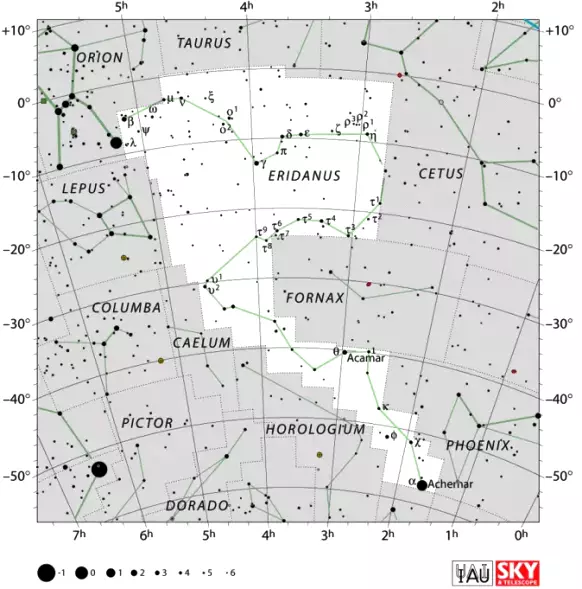
Eridanus constellation map by IAU and Sky&Telescope magazine
Eridanus myth
In Greek mythology, the constellation Eridanus is associated with the story of Phaëton (or Phaëthon), the son of the Sun god Helios and the Oceanid Clymene. According to legend, Phaëton wanted to drive his father’s chariot across the sky and kept begging for Helios’ permission to do so until the god agreed, advising Phaëton to follow the beaten track where he saw wheel marks.
Phaëton mounted the chariot and the horses, sensing that the driver was lighter, flew upwards into the sky, leaving the familiar track behind. The inexperienced driver could not control the horses and the reins slipped from his hands. The chariot plunged so close to the Earth that lands caught fire. It is said that this was how Libya became a desert, Ethiopians got dark skin, and the seas dried up. Zeus saw what was going on and had to intervene to prevent further calamity. He struck Phaëton down with a thunderbolt and, when Phaëton’s hair caught on fire, he leapt from the chariot and fell into the Eridanus. His father Helios, stricken with grief, did not drive his chariot for days, leaving the world in darkness.
The Greek poet Aratus called the constellation Eridanus, while a number of other sources, including Ptolemy, referred to it as Potamos, which means “the river.” The Greek astronomer and poet Eratosthenes associated the celestial river with the Nile, the only river that runs from south to north. Hyginus, a Latin author, agreed, pointing out that the bright star Canopus in the constellation Carina was at the end of the river much like the island Canopus lies at the mouth of the great river in Egypt. The actual constellation, however, represents a river that runs from north to south. Later, the river came to be identified as the river Po in Italy by Greek and Latin authors.
The name Eridanus, according to one theory, comes from the name of a Babylonian constellation known as the Star of Eridu (MUL.NUN.KI). Eridu was a Babylonian city held sacred to the god Enki-Ea. Enki-Ea was the ruler of the cosmic domain of the Abyss, usually imagined as a reservoir of fresh water below the Earth’s surface.
Eridanus stars
Achernar – α Eridani (Alpha Eridani)
Achernar, Alpha Eridani, is the brightest star in Eridanus constellation and the ninth brightest star in the night sky. It is located in the southern corner of the constellation. The star has an apparent magnitude that varies from 0.40 to 0.46 and is approximately 139 light years distant from Earth. It is the hottest and bluest among the ten brightest stars in the sky.
Achernar never rises above the horizon from locations north of the latitude 33° N and the best time to observe it in the southern hemisphere is during the month of November. The star never sets below the horizon for observers living south of the latitude 33° S.
Alpha Eridani has the stellar classification B6 Vep. It is a blue main sequence star 6.7 times more massive than the Sun and about 3,150 times more luminous. It has a class A companion twice as massive as the Sun in close orbit. The two stars are separated by about 12.3 astronomical units and orbit each other with a period of 14-15 years. The star is classified as a Lambda Eridani type variable.
Achernar is a very fast rotator, with a projected rotational velocity of 250 km/s. As a consequence, it is the least spherical star studied in the Milky Way galaxy. It has the shape of an oblate spheroid and its diameter at the equator is 56% greater than its polar diameter. The star has a circumstellar disk of gas, also as a consequence of fast spinning.
The name Achernar is derived from the Arabic ākhir an-nahr, which means “the end of the river.” It refers to the star’s position at the southern end of Eridanus.
Cursa – β Eridani (Beta Eridani)
Beta Eridani is a white giant star of the spectral type A3 III. It is the second brightest star in the constellation, with an apparent magnitude of 2.796. It lies approximately 89 light years from the solar system. Located at the northern end of Eridanus, near the border with Orion, the star is visible from most inhabited areas on Earth. It has a visual companion with an apparent magnitude of 10.90, located 120 arcseconds away.
Cursa has a mass double that of the Sun and a radius 2.4 times solar. With an effective temperature of 8,360 K, it is 25 times more luminous than the Sun. Like Achernar, it is a fast spinner, with a projected rotational velocity of 196 km/s.
Cursa is a variable star. Its brightness has been reported to vary from magnitude 2.72 to 2.80.
The star’s traditional name, Cursa, comes from the Arabic phrase Al Kursiyy al Jauzah, meaning “the chair (or footstool) of the central one.” The name originally referred to two other stars, Lambda Eridani and Psi Eridani. It is a reference to Beta Eridani’s position at the foot of Orion, marked by Rigel.
Acamar – θ Eridani (Theta Eridani)
Acamar, Theta Eridani, is a binary star that may be part of a multiple star system. The primary component is a white star of the spectral type A3IV-V, indicating a subgiant or main sequence star. It may itself be a spectroscopic binary. The companion is a star of the spectral type A4, separated by only 8.3 arcseconds from the primary. The two stars appear as a single star to the unaided eye. The system has a combined apparent magnitude of 2.91.
The primary component, Theta1 Eridani, is 2.6 times more massive and 16 times larger than the Sun. With a surface temperature of 8,200 K, it shines with 145 solar luminosities. The companion, Theta2 Eridani, has a mass of 2.4 solar masses and is 36 times more luminous than the Sun. It is slightly hotter than a primary, with an effective temperature of 9,200 K. The stars lie at an approximate distance of 161 light years.
The traditional name of Theta Eridani, Acamar, shares the same etymology with Achernar. It comes from the Arabic Ākhir an-nahr, meaning “the end of the river.” Acamar used to mark the end of the celestial river, Eridanus, before Achernar became known to European observers. Since Achernar is too far south to be visible from Greece, Acamar was chosen to mark the river’s end by Hipparchus and Ptolemy. Now it is the brighter Achernar that holds that distinction.
Zaurak – γ Eridani (Gamma Eridani)
Zaurak, Gamma Eridani, is a red giant star of the spectral type M0III-IIIb. With an apparent magnitude that varies from 2.88 to 2.96, it is the fourth brightest star in Eridanus. It lies at an approximate distance of 203 light years from Earth.
Zaurak is an evolved star on the asymptotic giant branch (AGB). It has expanded to a size of 80 solar radii and, with an effective temperature of 3,811 K, it shines with 1,259 solar luminosities. The star’s traditional name, Zaurak, comes from the Arabic word for “boat.”
Rana – δ Eridani (Delta Eridani)
Delta Eridani is an orange subgiant star of the spectral type K0 IV. It is classified as an RS Canum Venaticorum-type variable, a star whose brightness varies due to large stellar spots. The brightness of Delta Eridani has been observed to change from magnitude 3.51 to 3.56. The star lies at a distance of 29.49 light years. It is known by its traditional name, Rana, which means “frog” in Latin.
Ran – ε Eridani (Epsilon Eridani)
Epsilon Eridani is the 12th closest individual star to the Sun and the ninth nearest star or star system. It is the third nearest star that can be seen without binoculars, after Alpha Centauri and Sirius. It is also one of the nearest stars with a confirmed exoplanet. The star has an apparent magnitude of 3.736 and lies at a distance of 10.475 light years from Earth. As one of the nearest stars similar to the Sun, Epsilon Eridani has been the target of SETI (search for extraterrestrial intelligence) searches and often appears in works of science fiction.
Epsilon Eridani has the stellar classification K2V, indicating an orange main sequence star. It is slightly smaller and less massive than the Sun, with a mass of 0.82 solar masses and a radius of 0.735 solar radii. With a surface temperature of 5,084 K, it has only 34% of the Sun’s luminosity. The star has a projected rotational velocity of 2.4 km/s and completes a rotation every 11.2 days. Its estimated age is between 400 and 800 million years.
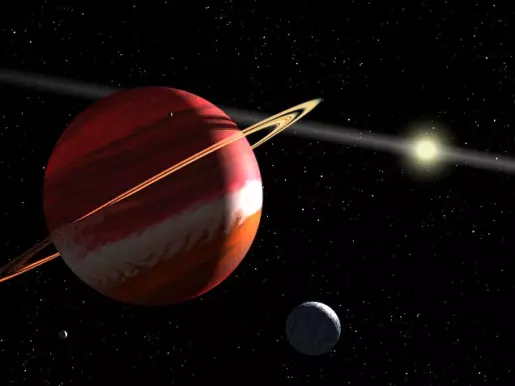
This is an artist’s concept of a Jupiter-mass planet orbiting the nearby star Epsilon Eridani. Located 10.5 light-years away, it is the closest known exoplanet to our solar system. The planet is in an elliptical orbit that carries it as close to the star as Earth is from the Sun, and as far from the star as Jupiter is from the Sun. Epsilon Eridani is a young star, only 800 million years old. It is still surrounded by a disk of dust that extends 20 billion miles from the star. The disk appears as a linear sheet of reflecting dust in this view because it is seen edge-on from the planet’s orbit, which is in the same plane as the dust disk. The planet’s rings and satellites are purely hypothetical in this view, but plausible. As a gas giant, the planet is uninhabitable for life as we know it. However, any moons might have conditions suitable for life. Image: NASA, ESA, and G. Bacon (STScI)
Epsilon Eridani is classified as a BY Draconis variable, a star that varies in brightness due to starspots coupled with the effect of rotation. The star has two asteroid belts orbiting at 3 astronomical units and 20 astronomical units from the star.
Epsilon Eridani was formally named Ran in 2015. It was named after Rán, the goddess of the sea in Norse mythology. The planet orbiting the star was named Ægir, after Rán’s husband and god of the ocean.
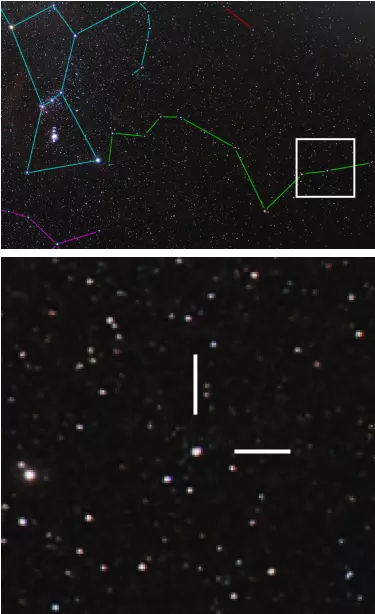
Location of Epsilon Eridani – Orion is shown in blue, Eridanus in green, Lepus in violet and Taurus in red. Epsilon Eridani is located at the center of the white square outline. Image: ESO/Y. Beletsky
The discovery of the giant planet, designated Epsilon Eridani b, was announced in 2000. The planet has a mass of 0.63 Jupiter masses and orbits the star with a period of 7.598 years at a distance of 3.52 astronomical units.
Tau Eridani
Tau Eridani is a designation shared by nine stars that do not appear very close to each other. Tau1 Eridani is separated by almost 20 degrees from Tau9 Eridani. The nine stars are not physically related.
Tau1 Eridani
Tau1 Eridani is a white main sequence star of the spectral type F7V. It has an apparent magnitude of 4.46 and lies 46 light years away. It is the primary component of a binary system with an orbital period of 958 days.
Angetenar – Tau2 Eridani
Angetenar, Tau2 Eridani, is an evolved orange giant located at an approximate distance of 187 light years from Earth. It has an apparent magnitude of 4.78. The star’s traditional name is derived from the Arabic phrase Al Ḥināyat an-Nahr, meaning “the bend in the river.” It refers to the star’s position in Eridanus.
Angetenar has a mass of 2.40 solar masses and a radius 8.12 times that of the Sun. With a surface temperature of 5,049 K, it is 42.7 times more luminous than the Sun. The star’s estimated age is about 660 million years.
Tau3 Eridani
Tau3 Eridani has the stellar classification A3 IV-V, indicating a star that is coming to an end of its main sequence lifetime if it has not already. The star has a mass 1.78 times that of the Sun and a radius 1.9 times solar. It shines with 13.7 solar luminosities with an effective temperature of 8,251 K. It is about 476 million years old.
Tau4 Eridani
Tau4 Eridani is a binary star consisting of a red giant of the spectral type M3/4 III and a magnitude 9.5 companion. The primary component is on the asymptotic giant branch (AGB) and classified as a slow irregular variable. Its brightness varies from magnitude 3.57 to 3.72 over a period of 23.8 days.
The star has a mass 1.8 times that of the Sun and has expanded to a size of 106 solar radii. With a surface temperature of 3.712 K, it is 1,537 times more luminous than the Sun.
Beid – Omicron¹ Eridani
Beid (38 Eridani) is a white giant star of the spectral type F0 III. It has a visual magnitude of 4.04 and lies at a distance of 122 light years from Earth. Beid is classified as a Delta Scuti variable, a young pulsating star whose brightness varies due to the pulsations over a period of a few hours. The brightness of Omicron¹ Eridani varies with an amplitude of 0.03 magnitudes every 0.0747 days. The star’s traditional name, Beid, comes from the Arabic bayḍ, meaning “eggs.”
Beid has a mass of 1.95 solar masses and a radius 3.7 times that of the Sun. With an effective temperature of 6,963 K, it shines with 27 solar luminosities. The star is a fast spinner, with a projected rotational velocity of 108.1 km/s.
Keid – Omicron2 Eridani
Keid is the primary component of a triple star system located at a distance of 16.26 light years from the Sun. The Omicron2 Eridani (40 Eridani) system consists of an orange dwarf of the spectral type K0.5 V, a class DA4 white dwarf, and a red dwarf with the stellar classification M4.5eV. The individual components have apparent magnitudes of 4.43, 9.52, and 11.17.
The two fainter components orbit Keid with a period of about 8,000 years at an approximate distance of 400 astronomical units. The components B and C also complete an orbit around a common centre of mass every 230.30 years. They are separated by about 35 astronomical units. All three stars are smaller, less massive, and less luminous than the Sun.
Keid, 40 Eridani A, has a mass of 0.84 solar masses and a radius of 0.81 solar radii. With a surface temperature of 5,300 K, it shines with 0.457 solar luminosities. The star’s estimated age is 5.6 billion years.
In 2018, a planet was discovered orbiting Keid with a period of 42.378 days. The planet does not lie in the habitable zone. It is much closer to the star, orbiting at a distance of 0.224 astronomical units. It has a mass 8.47 times that of the Earth and is one of the nearest Super-Earths known.
40 Eridani B has a mass of 0.573 solar masses and a size of 0.014 solar radii. With an effective temperature of 16,500 K, it shines with only 0.013 solar luminosities. The star is believed to be about 1.8 billion years old.
40 Eridani B was the first white dwarf discovered. The components B and C were discovered by William Herschel on January 31, 1783 and, in 1910, it was that discovered that the faint component B was white in colour.
40 Eridani C has a mass of only 0.2036 solar masses and a radius of 0.31 solar radii. It shines with only 0.008 solar luminosities with a surface temperature of 3,100 K.
40 Eridani has a special place in the Star Trek and Dune universes. In Star Trek, it is the host star of the planet Vulcan, while in the Dune novels it hosts the planet Richese. (In Star Trek: The Original Series, Vulcan was said to be orbiting Alnitak in Orion constellation, but this was later changed to 40 Eridani.)
82 G. Eridani (HD 20794, e Eridani)
82 G. Eridani is a yellow main sequence star of the spectral type G6V. It has an apparent magnitude of 4.254 and is only 19.71 light years distant from the solar system. It is a high velocity star, moving at 101 km/s relative to the Sun.
The star is smaller and less massive than the Sun. It has a mass of 0.70 solar masses and a radius 92% that of the Sun. It shines with 74% of the Sun’s luminosity with an effective temperature of 5,401 K. Its estimated age is between 6 and 12 billion years.
Three planets were discovered orbiting the star on August 17, 2011. The planets have only a few times the Earth’s mass and are classified as super-Earths.
EF Eridani
EF Eridani is an AM Herculis type variable, or a polar, which is a type of cataclysmic variable binary system that has a very strong magnetic field. It is located approximately 300 light years from Earth. The system’s visual magnitude varies between 14.5 and 17.3.
EF Eridani consists of a white dwarf star and a former star with a substellar mass orbiting the white dwarf. The substellar mass used to be a star which then lost all of its gas to the white dwarf. Now it is a ball with only 0.05 solar masses.
Deep sky objects in Eridanus
Witch Head Nebula – IC 2118
The Witch Head Nebula is a faint reflection nebula in Eridanus. It is thought to be a remnant of an ancient supernova or possibly a gas cloud illuminated by the bright star Rigel in the neighbouring Orion constellation.
The Witch Head Nebula had a notable mention in the TV show Andromeda as the site of the last major battle between the Commonwealth and the Nietzschean Alliance.
The nebula has an apparent magnitude of 13 and is approximately 1,000 light years distant from the solar system.
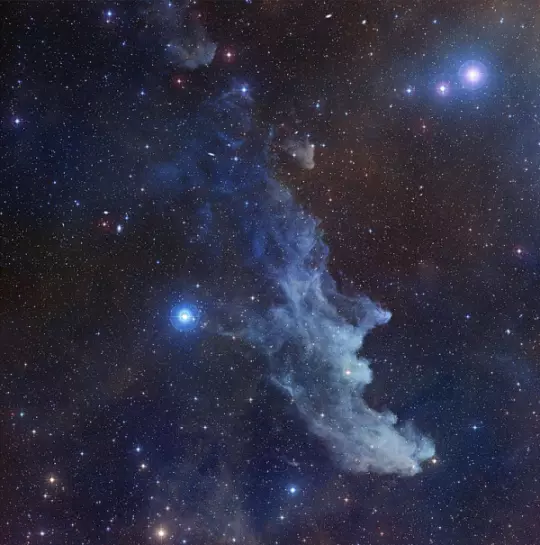
Witch Head Nebula (IC 2118), image: NASA/STScI Digitized Sky Survey/Noel Carboni
Eridanus Group (Eridanus Cloud)
The Eridanus Group, also known as the Eridanus Cloud, is a group of galaxies roughly 75 million light years distant in Eridanus. The group consists of about 200 galaxies, and about 70% of them are categorized as spiral and irregular galaxies. The other 30% are lenticular and elliptical galaxies. The brightest galaxy in the Eridanus Cloud is NGC 1407.
The galaxy group has several subgroups. The Eridanus Group (the term here applies to a subgroup) has 31 member galaxies, nine of which are listed in the New General Catalogue (NGC) and two in the Index Catalogue (IC). The brightest member is the elliptical galaxy NGC 1395. The other two subgroups are centred on the galaxies NGC 1407 (giant elliptical galaxy) and NGC 1332 (spiral galaxy).
NGC 1300
NGC 1300 is a barred spiral galaxy, about 110,000 light years across, with a visual magnitude of 11.4. It is approximately 61.3 million light years distant. The galaxy belongs to the Eridanus cluster of galaxies.
The central region of the galaxy has a grand design spiral structure some 3,300 light years long, a spiral within a spiral.

Barred spiral galaxy NGC 1300 photographed by Hubble telescope. In the core of the larger spiral structure of NGC 1300, the nucleus shows its own extraordinary and distinct “grand-design” spiral structure that is about 3,300 light-years (1 kiloparsec) long. Only galaxies with large-scale bars appear to have these grand-design inner disks — a spiral within a spiral. Models suggest that the gas in a bar can be funneled inwards, and then spiral into the center through the grand-design disk, where it can potentially fuel a central black hole. NGC 1300 is not known to have an active nucleus, however, indicating either that there is no black hole, or that it is not accreting matter. Image: NASA, ESA, and the Hubble Heritage Team
NGC 1084
NGC 1084 is an unbarred spiral galaxy with an apparent magnitude of 10.7. It lies at an approximate distance of 62.7 million light years from Earth and has an apparent size of 3’.2 by 1’.8. The galaxy is part of a group of galaxies that also includes NGC 988, NGC 991, NGC 1022 and several other galaxies in the constellation Cetus. The group is associated with the Messier 77 group.
NGC 1084 was discovered by William Herschel in 1785. Five supernovae were observed in the galaxy over a period of 49 years between 1963 and 2012. None of them reached unaided eye visibility.
NGC 1332
NGC 1332 is a spiral galaxy discovered by William Herschel on December 9, 1784. It has an apparent magnitude of 10.3.
NGC 1395
NGC 1395 is a bright, large elliptical galaxy in Eridanus. It has a visual magnitude of 9.8. The galaxy was discovered by William Herschel on November 17, 1784.
NGC 1232
NGC 1232 is an intermediate spiral galaxy. It has an apparent magnitude of 10.9 and is approximately 61 million light years distant. It is a member of the Eridanus cluster.
The nearby NGC 1232A is a satellite galaxy of NGC 1232. It is believed to be the cause of the unusual shape of the larger galaxy’s spiral arms.

This spectacular image of the large spiral galaxy NGC 1232 was obtained on September 21, 1998, during a period of good observing conditions. It is based on three exposures in ultra-violet, blue and red light, respectively. The colours of the different regions are well visible: the central areas contain older stars of reddish colour, while the spiral arms are populated by young, blue stars and many star-forming regions. Note the distorted companion galaxy on the left side, shaped like the Greek letter “theta”. Image: ESO
NGC 1234
NGC 1234 is another barred spiral galaxy. It has an apparent magnitude of 15.3. The galaxy was discovered by the American astronomer Francis Preserved Leavenworth in 1886.
Cleopatra’s Eye Nebula (NGC 1535)
NGC 1535 is a planetary nebula in Eridanus. It is similar in structure and colour to the Eskimo Nebula in the constellation Gemini, except for the fact that the central star in NGC 1535 is hard to observe.
The nebula is approximately 1,500 light years distant.
NGC 1531 and NGC 1532
NGC 1531 is a dwarf galaxy in Eridanus. It has a visual magnitude of 12.9. The galaxy is interacting with the larger spiral galaxy NGC 1532.
NGC 1532 is a barred spiral galaxy seen edge-on. It has an apparent magnitude of 10.7. It has several dwarf companion galaxies and is clearly interacting with one of them, NGC 1531.

The pair of galaxies NGC 1531/2, engaged in a spirited waltz, is located about 70 million light-years away towards the southern constellation Eridanus (The River). The deformed foreground spiral galaxy laced with dust lanes NGC 1532 is so close to its companion — the background galaxy with a bright core just above the centre of NGC 1532 — that it gets distorted: one of its spiral arms is warped and plumes of dust and gas are visible above its disc. The cosmic dance leads to another dramatic effect: a whole new generation of massive stars was born in NGC 1532 because of the interaction. They are visible as the purple objects in the spiral arms. Image: ESO
Eridanus Supervoid (CBM Cold Spot/WMAP Cold Spot)
The Eridanus Supervoid is the largest supervoid ever discovered. (A supervoid is an area of space that contains no galaxies.) It is about one billion light years in diameter.
Current theories of the origins of the universe cannot explain the supervoid, but it has been speculated that the supervoid may be the result of quantum entanglement between our universe and another.
The Eridanus Supervoid was discovered by linking a cold spot in the cosmic microwave background (CMB) to an absence of radio galaxies. Cosmic microwave background radiation refers to thermal radiation that fills the entire observable universe almost uniformly.
The CMB Cold Spot is a region of the universe seen in microwaves that is exceptionally large and cold relative to the average CMB radiation. A cold spot as large as the Eridanus Supervoid seems very unlikely in the accepted theoretical models.
NGC 1427A
NGC 1427A is an irregular galaxy in Eridanus. It has an apparent magnitude of 13.4 and is approximately 51.9 million light years distant.
NGC 1427A is the brightest dwarf irregular galaxy in the Fornax Cluster of galaxies, and lies in front NGC 1399, the central galaxy in the cluster, located in Fornax constellation.
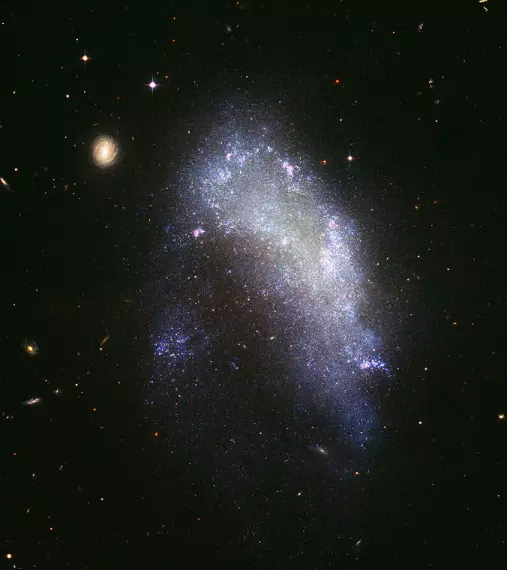
The irregular galaxy NGC 1427A will not survive long as an identifiable galaxy, passing through the Fornax cluster at nearly 600 kilometers per second (400 miles per second). Image: NASA, ESA, and the Hubble Heritage Team
NGC 1309
NGC 1309 is another spiral galaxy in Eridanus, seen face-on, and spanning some 30,000 light years. The galaxy is approximately 120 million light years distant from the solar system. It belongs to the Eridanus Group. It has an apparent magnitude of 12.0.
A Type Ia supernova, SN 2002fk, was observed in the galaxy in September 2002.
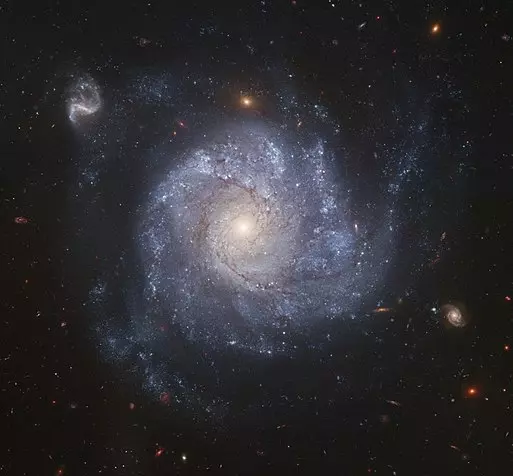
NGC 1309, image: NASA, the Hubble Heritage Team and A. Riess
NGC 1291
NGC 1291, sometimes also referred to as NGC 1269, is a ring galaxy in Eridanus. It is notable for the unusual structure of its outer ring and inner bar.
The galaxy was discovered by the Scottish astronomer James Dunlop in 1826, and included in the New General Catalogue as NGC 1291. John Herschel independently discovered the galaxy in 1836 and entered it as NGC 1269, not realizing that it already had a NGC number.
NGC 1291 is approximately 33 million light years distant. It has an apparent magnitude of 9.39.
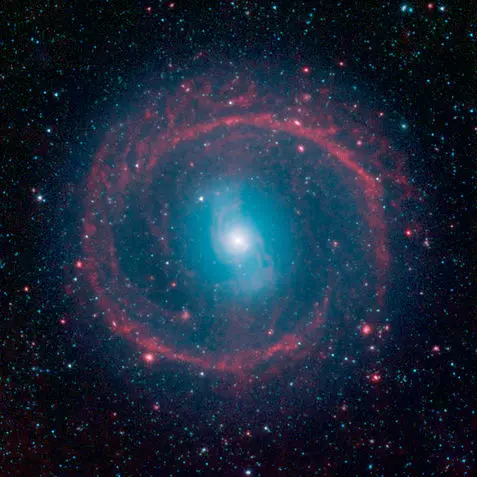
A new image from NASA’s Spitzer Space Telescope, taken in infrared light, shows where the action is taking place in galaxy NGC 1291. The outer ring, colored red in this view, is filled with new stars that are igniting and heating up dust that glows with infrared light. The stars in the central area produce shorter-wavelength infrared light than that seen in the ring, and are colored blue. This central area is where older stars live, having long ago gobbled up the available gas supply, or fuel, for making new stars. The galaxy is about 12 billion years old and is located 33 million light years away in the Eridanus constellation. It is known as a barred galaxy because a central bar of stars (which looks like a blue “S” in this view) dominates its center. When galaxies are young and gas-rich, stellar bars drive gas toward the center, feeding star formation. Over time, as the star-making fuel runs out, the central regions become quiescent and star-formation activity shifts to the outskirts of a galaxy. There, spiral density waves and resonances induced by the central bar help convert gas to stars. The outer ring, seen here in red, is one such resonance location, where gas has been trapped and ignited into a star-forming frenzy. Image: NASA/JPL-Caltech
NGC 1187
NGC 1187 is another spiral galaxy in Eridanus, seen almost face-on. It has a visual magnitude of 11.4 and is approximately 60 million light years distant from the solar system. It was discovered by William Herschel in 1784.
The galaxy was the site of two observed supernovae in the last few decades. One (SN 1982R) was discovered in October 1982 and the other (SN 2007Y) in 2007.

NGC 1187, image: ESO